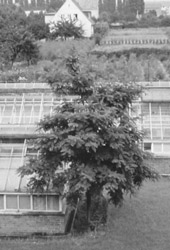|
The mutability "atom"
In 1958 Mundry finally managed to create in vitro mutations. At the time he was working in Tübingen again as Melchers' assistant after having spent some time working at the Brunswick College of Technology.
The new discovery was the high point of his work in Tübingen and was the product of his cooperation with Alfred Gierer from the Max Planck Institute for Virus Research.
Beforehand, Schramm and Heinz Schuster had been able to show that a random change in a single component of the nucleic acid (nucleotides) was enough to make the virus fail to function. In their experiments they had used nitrous acid.
Mundry and Gierer adopted this technique and demonstrated that a chemical change to a single nucleotide was not necessarily "fatal". Instead, it depended on which one of the over 6000 nucleotides was changed. This meant that they had discovered the smallest unit of mutation.
The tobacco mosaic virus was thus no longer just a model for virology, but was also a potential genetic model for molecular biology as a whole.

|
